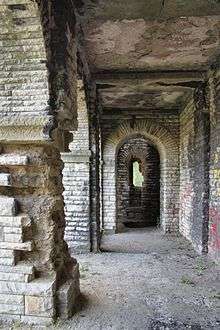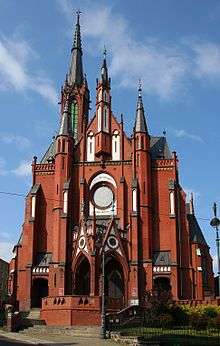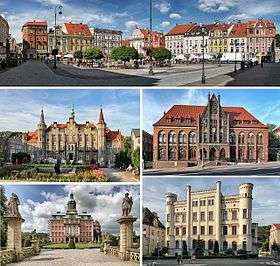Wałbrzych
| Wałbrzych | |||
|---|---|---|---|
|
Main sights in Wałbrzych | |||
| |||
 Wałbrzych | |||
| Coordinates: 50°46′N 16°17′E / 50.767°N 16.283°ECoordinates: 50°46′N 16°17′E / 50.767°N 16.283°E | |||
| Country | Poland | ||
| Voivodeship | Lower Silesian | ||
| County | city county | ||
| Established | 9th century | ||
| City rights | 1400 to 1426 | ||
| Government | |||
| • Mayor | Roman Szełemej | ||
| Area | |||
| • Total | 84.70 km2 (32.70 sq mi) | ||
| Elevation | 350 m (1,150 ft) | ||
| Population (31 December 2010) | |||
| • Total | 120,197 | ||
| • Density | 1,400/km2 (3,700/sq mi) | ||
| Time zone | CET (UTC+1) | ||
| • Summer (DST) | CEST (UTC+2) | ||
| Postal code | 58-300 to 58-309, 58-316 | ||
| Area code(s) | +48 74 | ||
| Car number plates | DB, DBA | ||
| Website |
www | ||

Wałbrzych [ˈvau̯bʐɨx] (German: Waldenburg; Lower Silesian: Walmbrig or Walmbrich; Czech: Valbřich or Valdenburk) is a city in Lower Silesian Voivodeship in southwestern Poland. From 1975–1998 it was the capital of Wałbrzych Voivodeship; it is now the seat of Wałbrzych County. Wałbrzych lies approximately 70 kilometres (43 mi) southwest of the voivodeship capital Wrocław and about 10 kilometres (6 miles) from the Czech border.
Etymology
According to the city's official website, the early Polish name of the settlement was Lasogród ("forest castle").[1] The German name Waldenburg (also meaning "forest castle") referred to the castle Nowy Dwór (German: Burg Neuhaus), whose ruins stand south of the city; the name came to be used for the entire settlement.[2] It first appeared in the 15th century, coming from the words Wald (forest) and Berg (mountain) later associated with the castle.[3] The modern Polish name "Wałbrzych" comes from the German name Walbrich, a late medieval linguistic variation of the older names "Wallenberg" or "Walmberg".[4]
History
Middle Ages
Polish sources indicate the city's predecessor, Lasogród, was an early medieval Slavic settlement[5] whose inhabitants engaged in hunting, honey gathering, and later agriculture. Lasogród eventually developed into a defensive fort, the remains of which were destroyed in the 19th century during expansion of the city.[6] However, some German sources say no archaeological or written records support notions of an early Slavic settlement or the existence of a castle before the late 13th century,[7] and that during the Middle Ages the area was part of the unpopulated Silesian forest (Polish: Silesian Przesieka; German: Schlesischer Grenzwald).[8][9][10] According to 17th-century Polish historian Ephraim Naso, Wałbrzych was a small village by 1191.[11] This assertion was rejected by 19th-century German sources[12] and by German historian Hugo Weczerka,[13] who says the city was founded between 1290 and 1293, and was mentioned as Waldenberc in 1305.[2] He places the city near Nowy Dwór (German: Neuhaus), built by Bolko I the Strict of the Silesian Piasts.[2] The city website, however, cites the building of the castle as a separate event in 1290.[1] A part of Nowy Dwór castle, a manor built in the 17th century, was destroyed in the 19th century.[14]
The settlement was first mentioned as a town in 1426, but it did not receive the rights to hold markets or other privileges due to the competition of nearby towns and the insignificance of the local landlords. Subsequently, the city became the property of the Silesian knightly families, initially the Schaffgotsches in 1372, later the Czettritzes, and from 1738, the Hochberg family, owners of Fürstenstein Castle.
Modern era
Coal mining in the area was first mentioned in 1536. The settlement was transformed into an industrial centre at the turn of the 19th century, when coal mining and weaving flourished. In 1843 the city obtained its first rail connection, which linked it with Breslau (now Wrocław, Poland). In the early 20th century a glassworks and a large china tableware manufacturing plant, which are still in operation today, were built. In 1939 the city had about 65,000 inhabitants. It was conquered by the Soviet Red Army on 8 May 1945 - coincidentally, the day World War II in Europe ended.
After World War II, Waldenburg was transferred to Poland under border changes promulgated at the Potsdam Conference, most of the native German population was forcibly expelled, and the city was renamed Wałbrzych.[15][16] However, Wałbrzych was one of the few areas where a number of Germans[17] were held back as they were deemed indispensable for the economy, e.g. coal mining.[18] An ethnic German society has been maintained in Walbrzych since 1957.[18]
The city was relatively unscathed by the Second World War, and as a result of combining the nearby administrative districts with the town and the construction of new housing estates, Wałbrzych expanded geographically. At the beginning of the 1990s, because of new social and economic conditions, a decision was made to close down the town's coal mines. In 1995, a Museum of Industry and Technology was set up on the facilities of the oldest coal mine in the area, KWK THOREZ. The 2005 the film Komornik was filmed in and around Wałbrzych.
In 2015 Walbrzych became widely known due to the search for a supposedly buried Nazi gold train.
Sights
- Książ Castle (German: Schloss Fürstenstein), the largest Silesian castle, the third-largest castle in Poland behind Kraków's Wawel and the Teutonic Order fortress at Malbork.
- Chełmiec Mountain
- Palmiarnia
- Market square (renovated 1997–1999)
- Czettritz Castle (1604–1628)
- Alberti Castle (1801), housing the Municipal Museum
- St. Mary's (1305, ren. 1720)
- Protestant Church (1785–1788)
- The mysterious mausoleum of Hitler
- Old Mine - Center for Science and the Arts (Stara Kopalnia - Centrum Nauki i Sztuki)

City districts


Including date of incorporation into the city
|
|
Education
- Angelus Silesius State University in Wałbrzych official site
- Wrocław Technical University in Wałbrzych official site
- Wałbrzyska Wyższa Szkoła Zarządzania i Przedsiębiorczości official site
- Ignacy Paderewski High School official site
- Hugo Kołłątaj High School official site
- Mikołaj Kopernik High School official site
- The city has a research center, Polish Academy of Sciences
Politics
Wałbrzych constituency
Members of Parliament (Sejm) elected from Wałbrzych constituency:
- Zbigniew Chlebowski, PO
- Henryk Gołębiewski, SLD
- Roman Ludwiczuk, PO (Senat)
- Katarzyna Mrzygłocka, PO
- Giovanni Roman, PiS
- Mieczysław Szyszka, PiS (Senat)
- Anna Zalewska, PiS
Sports
- Górnik Wałbrzych (also known as Victoria Górnik Wałbrzych) is a professional men's basketball club. Currently, the Górnik Wałbrzych plays in the Polish 3rd league. Last time Górnik played in Polish Basketball League – the Polish top basketball league was in 2009.
- PWSZ Górnik Wałbrzych is a professional men's football club playing in the Polish 3rd league (4 level).
- KK Wałbrzych (former Gornik Nowe Miasto Wałbrzych) – is a semi-professional men's basketball club playing in the Polish 3rd league.
- Victoria PWSZ Wałbrzych is a professional men's volleyball club playing in the Polish 3rd league.
There are many semi-professional or amateur football clubs (like Zagłębie Wałbrzych, Juventur Wałbrzych, Podgórze Wałbrzych, Gwarek Wałbrzych, Czarni Wamag Wałbrzych and one basketball club (KS Dark Dog is playing in the Polish 3rd league).
- LKKS Górnik Wałbrzych is a cycling club
- Wałbrzych native Sebastian Janikowski is a placekicker in the NFL.
Media
- New Walbrzych Headlines official site
- Tygodnik Wałbrzyski official site
- www.walbrzych.info official site
- TV Zamkowa official site
- TV Walbrzych official site
- 30 minut – Gazeta która nie ma ceny ((Free) Newspaper – that does not have a price) official site
Notable people
- Wolfgang Menzel, (1798–1873) German poet, critic and literary historian
- Gerhard Menzel (1894–1966), German writer
- Abraham Robinson (1918–1974) German-Jewish-American mathematician
- Klaus Töpfer, German politician (CDU), born 1938 in Waldenburg
- Christian Brückner German actor, b. 1943
- Marcel Reif, German soccer journalist, born 1949 in Wałbrzych
- Sebastian Janikowski, Polish-American football placekicker for the NFL Oakland Raiders, b. 1978
- Adrian Mrowiec, Polish footballer for Chemnitzer FC, b. 1983
International relations
Twin towns — sister cities
Wałbrzych is twinned with:
|
See also
- Piotr Giro
- Flight and expulsion of Germans from Poland during and after World War II
- Nazi gold train
References
Bibliography
- Badstübner, Ernst; Dietmar Popp; Andrzej Tomaszewski; Dethard von Winterfeld (2005). Dehio – Handbuch der Kunstdenkmäler in Polen: Schlesien. München, Berlin: Deutscher Kunstverlag 2005. ISBN 3-422-03109-X.
- Petry, Ludwig; Josef Joachim Menzel; Winfried Irgang (2000). Geschichte Schlesiens. Band 1: Von der Urzeit bis zum Jahre 1526. Stuttgart: Jan Thorbecke Verlag Stuttgart. ISBN 3-7995-6341-5.
- Thum, Gregor (2003). Die fremde Stadt. Breslau 1945. Berlin: Siedler. ISBN 3-88680-795-9.
- Weczerka, Hugo (2003). Handbuch der historischen Stätten: Schlesien, Second Edition. Stuttgart: Kröner Stuttgart. ISBN 3-520-31602-1.
Notes
- 1 2 "Portal Urzędu Miejskiego w Wałbrzychu". um.walbrzych.pl.
- 1 2 3 Weczerka, p.555.
- ↑ "Witamy w PORADNI JĘZYKOWEJ". us.edu.pl.
- ↑ Barbara Czopek, Adaptacje niemieckich nazw miejscowych w języku polskim, 1995, p.55, ISBN 83-85579-33-8
- ↑ Słownik geograficzno-krajoznawczy Polski Maria Irena Mileska 1994 page 781 Wydawn. Nauk. PWN, 1994
- ↑ "Historia Wałbrzycha". Wałbrzych City Office. Retrieved 2 April 2009.
- ↑ Vorgeschichtliche Funde innerhalb des Stadtgebietes sind spärlich und zweifelhaft in der Deutung, so daß eine frühe Dauersiedlung nicht angenommen werden kann. Für die Existenz einer "Waldenburg" im Bereich der Altstadt gibt es keinerlei Anhaltspunkte. Weczerka, p.555
- ↑ Auch der Grenzwald spricht dagegen. Weczerka, pp.416 and 555
- ↑ Badstübner, p.2.
- ↑ Petry, p.11.
- ↑ Kronika wałbrzyska Wałbrzyskie Towarzystwo Kultury, Państwowe Wydawnictwo Naukowe 1985 page 231
- ↑ Allgemeine Deutsche Biographie, Band 23, page 261, Markgraf, Duncker & Humblot, 1886
- ↑ Die Behauptung, die "Waldenburg" sei 1191 erbaut worden (Naso), ist nicht haltbar. Weczerka, p.555
- ↑ Weczerka, p.341.
- ↑ Polski Kalendarz Katolicki dla Kochanych Wiarusów Prus Zachodnich page 77 http://www.wbc.poznan.pl/dlibra/docmetadata?id=259791&from=&dirids=1&ver_id=&lp=2&QI=
- ↑ Katalog Prowincyonalnej wystawy przemysłowej w Poznaniu 1895 page 71 Werbebeilage http://www.wbc.poznan.pl/dlibra/docmetadata?id=130018&from=&dirids=1&ver_id=&lp=7&QI=
- ↑ Werner Besch, Dialektologie: Ein Handbuch zur Deutschen und allgemeinen Dialektforschung, Walter de Gruyter, 1982, p.178, ISBN 3-11-005977-0
- 1 2 Stefan Wolff, German Minorities in Europe: Ethnic Identity and Cultural Belonging, Berghahn Books, 2000, p.79, ISBN 1-57181-504-X
External links
| Wikimedia Commons has media related to Wałbrzych. |
| Wikivoyage has a travel guide for Wałbrzych. |
| Wikisource has the text of the 1911 Encyclopædia Britannica article Waldenburg. |
- Wałbrzych official city website
- Wałbrzych information website
- Jewish Community in Wałbrzych on Virtual Shtetl
- Local news website (pol)
- Wałbrzych photo gallery and local news



